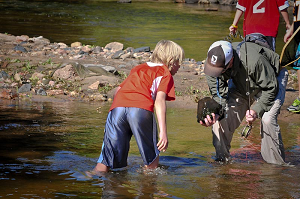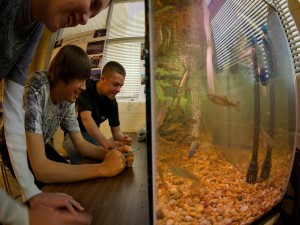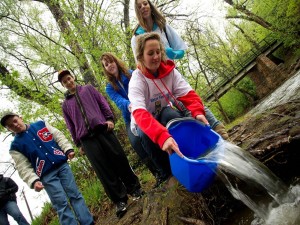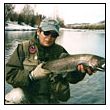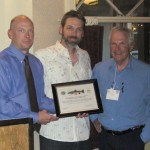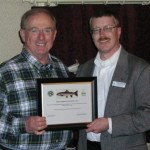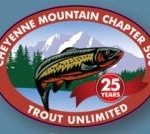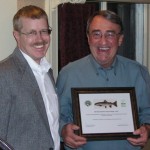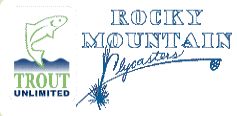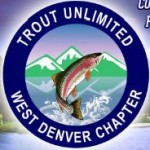The Roan Plateau near Rifle is one of Colorado’s gems – a scenic backcountry area supporting some of Colorado’s best big game habitat and providing a home for populations of native cutthroat trout that have a unique local adaptation – the ability to withstand warmer water temperatures than most other cutthroats.

The Roan’s outstanding fish and wildlife values led Field & Stream magazine to name it one of their “Best Wild Places.” The Colorado Water Quality Control Commission has designated several key streams on the Roan as “Outstanding Waters,” deserving of unique water quality standards. And the Colorado Natural Heritage Program at Colorado State University – a source of information on the state’s rarest and most threatened species and plant communities – has recognized the Roan as one of Colorado’s top four locations for biologic diversity. Of those four places, only the Roan does not benefit from the protective management of the National Park Service.
It’s clear that there is broad recognition that the Roan is a special place. But over the past decade it has become an island of quality habitat in the vast sea of energy development taking place throughout the Piecance basin.
In the final months of the Bush administration, the Bureau of Land Management (BLM) approved a wide-ranging plan for oil and gas drilling atop the Roan Plateau that seemed indifferent to appropriate protections for fish and wildlife. And in short order, leases for energy development were auctioned off.
Remarkably, even BLM acknowledged dire impacts on fish and wildlife. Its own analysis projected that the agency’s drilling plan would result in a 33% decline in mule deer herds and could even eliminate rare native trout populations. And as troubling as these projections might have been, it’s likely the study grossly understated the real impacts. While BLM worked under the assumption that 300 wells would be drilled on the plateau, the Bill Barrett Company, which holds the leases atop the Roan, plans to drill 3,000 wells - more than ten times the BLM estimate.
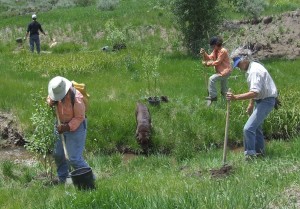
Trout Unlimited is no “Johnny-come-lately” when it comes to protecting the important resource values of the Roan Plateau. The Grand Valley TU Chapter has been engaged in on-the-ground efforts to protect and restore habitat atop the Roan since the 1990s, constructing fence to keep cattle off of important stream reaches, installing in-stream habitat features, planting riparian vegetation, and monitoring water quality.
Trout Unlimited accepts the need for responsible development of natural gas resources. In fact, Colorado TU supported an alternative drilling plan for the Roan that would have allowed development of the vast majority of its natural gas without having to disturb key fish and wildlife habitats. Unfortunately, drilling on the scale approved by BLM threatens to wipe out native trout populations and habitat that TU volunteers and professional staff have worked for decades to preserve, and defies any interpretation of “responsible.”
And so, with the future of the Roan’s trout on the line, Colorado TU joined other conservation-minded groups to challenge BLM’s ill-conceived plan in federal court. TU and its partners were represented in that effort by an outstanding legal team from the environmental legal group, Earthjustice.
There has been some recent good news for the Roan campaign: First, the presiding federal district court judge ruled in favor of our challenge to the BLM plan, by directing the agency to revisit its environmental analysis and decision. The very same afternoon, TU was approved for a foundation grant of more than $100,000 to support restoration work atop the Roan Plateau – improving stream crossings, fencing riparian habitat, and restoring cutthroats into new waters. In less than 24 hours, we went from facing the prospect of losing the Roan’s native trout to the opportunity to protect and restore their habitat on a larger scale than ever before.
The legal ruling favored TU and its partners on three key issues. The first two related to the need for improved air quality and ozone analysis. The third, and perhaps most significant, was a finding that BLM erred when it neglected to consider alternatives such as those supported by Colorado TU, which would have allowed for gas development while preserving key habitats on the Roan.
The judge’s decision is an important victory for the Roan Plateau and those who care about its future. It gives the BLM a second chance to “get it right” for the Roan, by coming up with a plan that allows responsible development while protecting the unique and valuable habitats both atop the Roan and along its base. But it is only a chance – the ruling does not assure that BLM will adopt an improved plan, only that it properly consider alternatives and analyze impacts. It will be up to Coloradoans to weigh in with BLM to ensure that the agency does adopt a new and better plan for the Roan. Colorado TU and other sportsmen’s groups will be a key part of these efforts.
Doing right by the Roan is about more than just advocating for responsible development. TU is also working on-the-ground to help protect and improve habitat for native trout. This year, we are working to complete a fish barrier on the East Fork of Parachute Creek that will help protect cutthroat habitat from invasion by brook trout, which can displace the native populations. We are also completing habitat improvements on Trapper Creek, home to a unique population of cutthroats that have managed to adapt to the somewhat warmer water temperatures found on the plateau. These improvements will help create new pools - holding water - that provides a safe haven for the fish during times of low streamflows.
TU’s habitat restoration work is carried out through the generosity of many key funding partners, including Colorado Parks and Wildlife and the National Fish and Wildlife Foundation. But oil and gas companies have also been important supporters of on-the-ground restoration through the Colorado Department of Public Health and Environment’s “Supplemental Environmental Project” (SEP). SEP allows companies facing fines for pollution violations to invest that money to improve habitat and environmental quality.

Besides engaging our established members in habitat protection and restoration in one of Colorado’s best wild places, the Roan also represents an opportunity for Colorado TU to connect with young people and help them develop their own “conservation ethic.” We have teamed up with the Rocky Mountain Youth Corps to deploy a youth conservation corps atop the Roan. One recent project involved planting cottonwood trees and willows along Trapper Creek to help improve riparian conditions in the watershed.
The efforts of the Youth Corps are supported The Greenbacks, a recently formed group of Denver area TUers in their 20s and 30s. In addition to fund raising efforts, the Greenbacks organized their own volunteer day to plant willows along another Roan cutthroat stream, Northwater Creek. And the Grand Valley Anglers chapter continues its decades-long commitment to the Roan by participating as funding partners and volunteers in virtually all the work taking place on the Roan’s native trout streams.
Of course, it can be argued that there are plenty of so-called special places, and that our need for jobs and new sources of energy require trade-offs. We can’t preserve everything. Sacrifices have to be made.
To be sure, there’s truth in that argument, especially in light of a growing population and struggling economy. But there is also a profound truth in the fable of the goose that laid the golden egg. Wouldn’t it be much more prudent to enjoy some economic benefit from the resources beneath the Roan without being so greedy as to kill it?
Over the past 50 years, TU has built a reputation for advocacy based on sound science and successful restoration projects build with the sweat equity of a hundred thousand volunteers. Protecting and restoring places is why we exist as an organization, even if it’s not always the perfect fit for the faint of heart. Sometimes, there’s no choice but to put up a fight. In the case of the Roan, more than ever, it is looking like a fight we can win.
Background on the Roan Plan
On June 8, 2007, the Bureau of Land Management issued its Record of Decision for the Roan Plateau management plan, giving approval to move forward with oil and gas development atop the Roan. CTU had numerous concerns with the plan - including the BLM's own conclusion that their proposal could result in elimination of rare native cutthroat trout populations atop the Roan. An overview of CTU's concerns with the BLM plan appears on a separate page on this site.
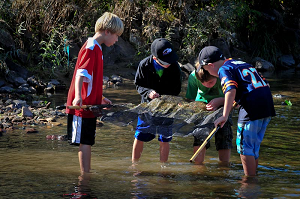 That is why it made perfect sense when a local Cub Scout Troop who was interested in getting their Scouts on the water approached DTU and Trout’s. Here is what we were able to pull off after a morning volunteering at the Greenway Foundation's fall river sweep.
That is why it made perfect sense when a local Cub Scout Troop who was interested in getting their Scouts on the water approached DTU and Trout’s. Here is what we were able to pull off after a morning volunteering at the Greenway Foundation's fall river sweep.





